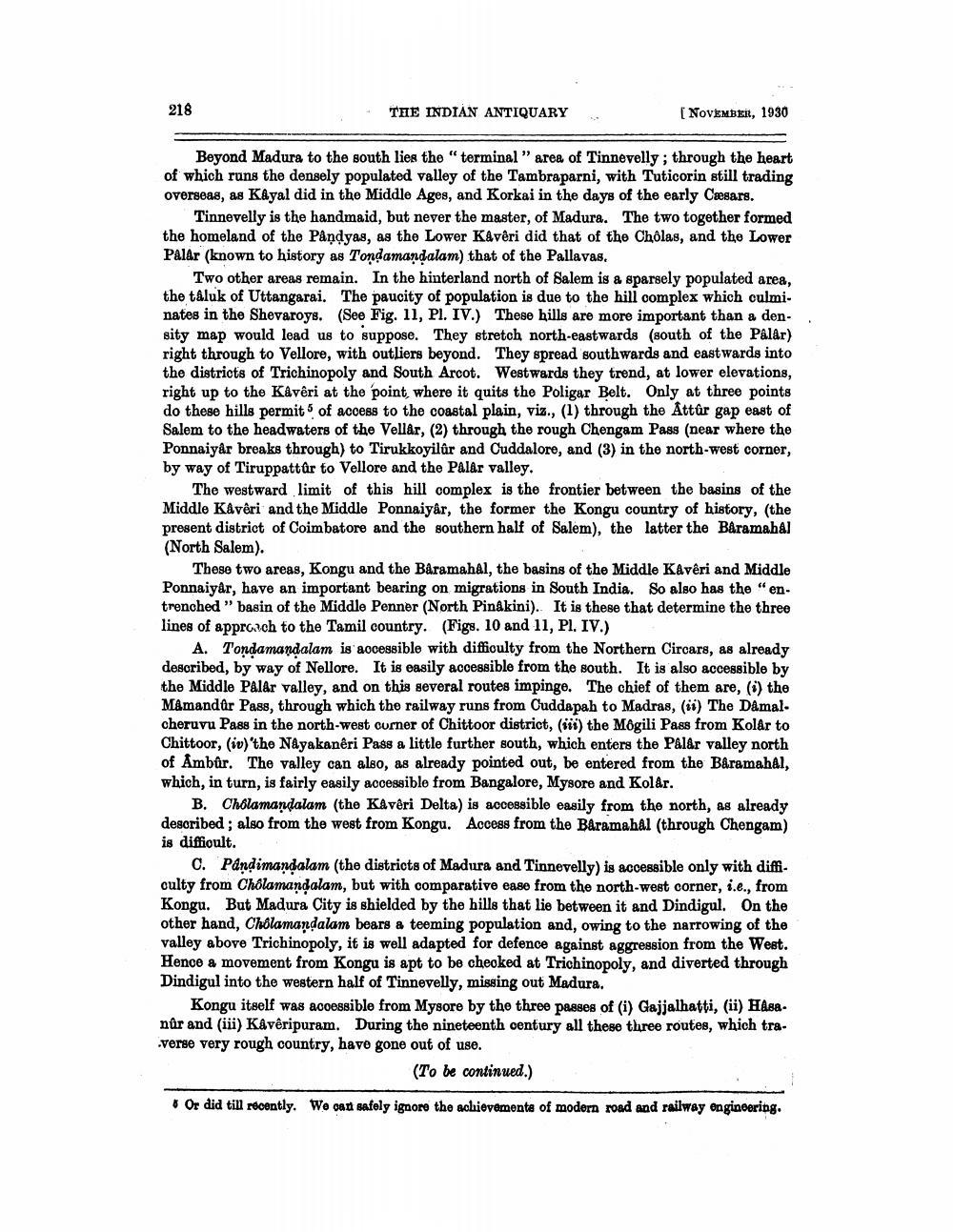________________
218
THE INDIAN ANTIQUARY
[ NOVEMBER, 1930
Beyond Madura to the south lies the "terminal" area of Tinnevelly; through the heart of which runs the densely populated valley of the Tambraparni, with Tuticorin still trading overseas, as Kayal did in the Middle Ages, and Korkai in the days of the early Cæsars.
Tinnevelly is the handmaid, but never the master, of Madura. The two together formed the homeland of the Pandyas, as the Lower Kavêri did that of the Cholas, and the Lower Palar (known to history as Tondamandalam) that of the Pallavas.
Two other areas remain. In the hinterland north of Salem is a sparsely populated area, the taluk of Uttangarai. The paucity of population is due to the hill complex which culminates in the Shevaroys. (See Fig. 11, PI. IV.) These hills are more important than a density map would lead us to suppose. They stretch north-eastwards (south of the Palar) right through to Vellore, with outliers beyond. They spread southwards and eastwards into the districts of Trichinopoly and South Arcot. Westwards they trend, at lower elevations, right up to the Kávéri at the point where it quits the Poligar Belt. Only at three points do these hills permit 5 of access to the coastal plain, viz., (1) through the Attür gap east of Salem to the headwaters of the Vellår, (2) through the rough Chengam Pass (near where the Ponnaiyar breaks through) to Tirukkoyilûr and Cuddalore, and (3) in the north-west corner, by way of Tiruppattar to Vellore and the Palar valley.
The westward limit of this hill complex is the frontier between the basing of the Middle Kavêri and the Middle Ponnaiyår, the former the Kongu country of history, (the present district of Coimbatore and the southern half of Salem), the latter the Baramahal (North Salem).
These two areas, Kongu and the Baramahal, the basins of the Middle Kaveri and Middle Ponnaiyar, have an important bearing on migrations in South India. So also has the "en. trenched " basin of the Middle Penner (North Pinakini). It is these that determine the three lines of approach to the Tamil country. (Figs. 10 and 11, PI. IV.)
A. Tondamandalam is accessible with difficulty from the Northern Circars, as already described, by way of Nellore. It is easily accessible from the south. It is also accessible by the Middle Palar valley, and on this several routes impinge. The chief of them are, (i) the MAmandar Pass, through which the railway runs from Cuddapah to Madras, (ii) The Damal. cheruvu Pass in the north-west corner of Chittoor district, (*) the Mógili Pass from Kolar to Chittoor, (iv) the Nayakanêri Pass a little further south, which enters the Palar valley north of Ambûr. The valley can also, as already pointed out, be entered from the Baramahal, which, in turn, is fairly easily accessible from Bangalore, Mysore and Kolår.
B. Cholamandalam (the Kávéri Delta) is accessible easily from the north, as already described ; also from the west from Kongu. Access from the Baramahal (through Chengam) is difficult.
C. Pandimandalam (the districts of Madura and Tinnevelly) is accessible only with difficulty from Cholamandalam, but with comparative ease from the north-west corner, i.e., from Kongu. But Madura City is shielded by the hills that lie between it and Dindigul. On the other hand, Cholamandalam bears a teeming population and, owing to the narrowing of the valley above Trichinopoly, it is well adapted for defence against aggression from the West. Hence a movement from Kongu is apt to be cheoked at Trichinopoly, and diverted through Dindigul into the western half of Tinnevelly, missing out Madura.
Kongu itself was accessible from Mysore by the three passes of (i) Gajjalhatti, (ii) Hasanur and (iii) Kávêripuram. During the nineteenth century all these three routes, which traverse very rough country, have gone out of use.
(To be continued.)
Or did till recently. We can safely ignore the achievements of modern road and railway engineering.




